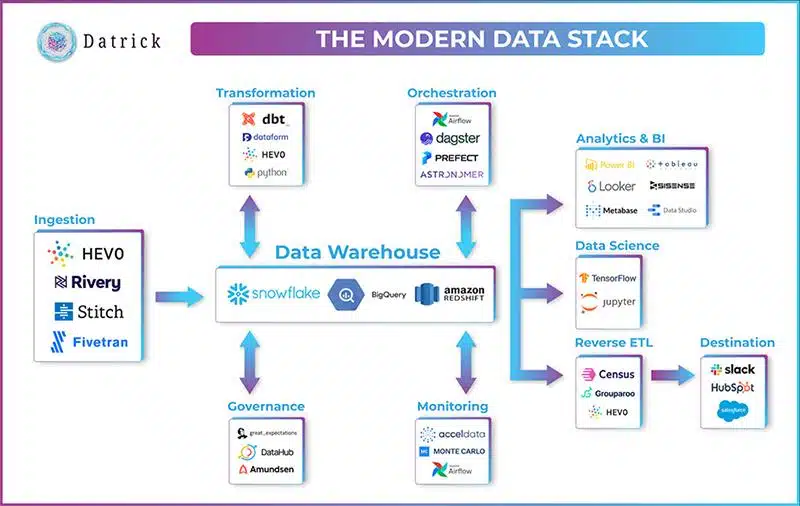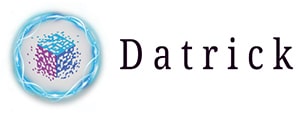
What Is the Modern Data Stack and Why You Need It
Your data is the fuel of your business. The more data you work with, the more strategic, competitive, and data-driven your business decisions can be. However, managing large volumes of data can lead to significant time and resource requirements. This is why many businesses rely on the modern data stack.
What Is the Modern Data Stack?

The modern data stack, or MDS for short, is a suite of tools and technologies that helps organizations collect, process, store, and analyze data. In essence, it makes raw data easily accessible, meaningful, and usable.
If you are new to the modern data stack, you can think of cooking and crafting as analogies. Raw ingredients, such as raw vegetables and meats, can be difficult to digest or even harmful. Meanwhile, raw materials such as wood, metal, or wool may not be useful or easily applicable. You need tools, utensils, appliances, as well as certain skills and processes to prepare meals and craft items.
The same occurs with raw data. Without the modern data stack, you and your employees are likely to have a hard time accessing, understanding, and interpreting raw data. What’s more, the process can be extremely time- and resource-consuming.
Here’s where the modern data stack comes in. It makes sure that all your organization’s data is:
- Collected in real-time from a wide range of third-party sources,
- Transformed so that it follows the same format and is usable,
- Aggregated in the same place, such as your data warehouse or data lake, and
- Presented in a meaningful way so that it empowers your organization’s teams to make strategic business decisions.
Most tools and technologies in the modern data stack are open-source. They can be managed by internal IT teams or teams of data engineers and analysts.
Modern Data Stack vs. Legacy Data Stack
The modern data stack is a relatively new concept. Its first versions date back to the early 2000s. Prior to that, companies relied on the traditional, also referred to as legacy, data stack.
So, what makes the modern data stack modern?
The greatest difference between the modern data stack and the traditional data stack is hosting. The MDS is hosted in the cloud as opposed to the traditional data stack that’s hosted on-premises. This offers organizations a more practical and cost-effective solution that is easier to scale.
Since on-premises data stacks require businesses to purchase the servers and technology necessary, it demands a significant initial investment. As a business outgrows the capabilities of its initial on-premises setup, upgrades and purchasing additional servers can be costly. Estimating exactly how many servers you’d need can also be difficult.
The technical requirements are also significantly lower for the modern data stack. You do not have to be a master in IT with years of experience behind your belt to make use of the MDS tools and technologies. And if you’re too busy to handle it yourself, contracting MDS specialists can be a good idea. It also tends to be more cost-effective than having your own on-premises servers. That’s because you’d need to purchase and maintain your own equipment and hire data stack professionals to assist you with data-stack-related tasks.
Hiring MDS contractors for a short amount of time is another cost-effective option that is cheaper than having your own team of developers. MDS experts can consult you, develop data pipelines and MDS infrastructure, migrate your data, and after that, assist you on an ad-hoc basis if and when you need it.
How Does the Modern Data Stack Work?
The MDS is responsible for making raw data usable, effective, and beneficial. It consists of various components, each of which complements the other and has its unique purpose and tools that facilitate it.
Understanding the basics and roles of the modern stack components can help you make informed choices when selecting MDS tools for your business. These are the main components of the modern data stack in the order in which data flows:
1. Data Collection
To work with data, you need to gather the data first. Without data, the data stack has no purpose. So, the first component of the MDS involves the process of collecting behavioral and transactional data on your clients or customers from a variety of sources.
Pretty much anything that is valuable for your business can serve as a source. Here are some examples of third-party data sources:
- CRM tools,
- Analytics tools,
- Social media platforms,
- Website,
- Mobile applications,
- Databases,
- Excel sheets, and much more
The role that tools or third-party sources play is ensuring that the data is valid and collected in real time.
2. Data Integration
Data ingestion is the process of transferring raw data from its source and loading it to a centralized data warehouse or data lake. Modern data pipelines usually have data from many different sources. As a business grows, it needs to lay new ingestion pipelines to adequately move new data.
ETL Method of Data Integration
The role data ingestion tools play is improving productivity and making sure that data is valid and high-quality. However, the process is not straightforward. This is due to the fact that all data is not the same, and it can exist in various forms. However, data storage systems only accept standardized data for the purpose of remaining organized.
Therefore, the data ingestion process known as ETL (Extract-Transform-Load) is comprised of three distinct steps:
- Extract: the process of getting data from its sources,
- Transform: the cleansing and standardizing of data so that it follows the format that the target destination that the organization is using will accept, and
- Load: placing the uniform data into the target destination (data warehouse or data lake) where the organization will store and analyze it
ETL vs. ELT in Data Integration
ETL and ELT are both data integration methods. ETL is an older one. It’s great when working with smaller data sets that require complex transformations. Yet, as data and data sources evolve, so do the tools and methods that facilitate them. Therefore, ELT (Extract-Load-Transform) has emerged as a more recent technology. It’s a more flexible method that can process both structured and unstructured data.
The primary difference between ETL and ELT is that:
- ETL transforms rata before loading it into the target destination, whereas
- ELT loads data into the target destination and transforms it afterward.
Each business’s data needs differ. Therefore, it’s important to reflect on your business needs and goals to choose the best data integration method as well as tools.
If you are unsure of which you would benefit from the most, experienced data engineers or analysts can point you in the right direction.
As per data integration tools, Hevo, Fivetran, and Stitch are popular and trusted by many businesses.
3. Data Storage
Nowadays, storing large volumes of data is cheaper and easier than it’s ever been. There are also many different ways to do so.
Data Warehouses
Data warehouses store processed data that has a specific purpose within the company. Business professionals are the primary people who use and benefit from this data.
There are two forms of cloud data warehouses: managed and unmanaged. Unmanaged cloud data warehouse providers like AWS Redshift charge based on your instance size, and it determines both your storage and compute capacity. So, if you need to upgrade either your storage or compute capacity, you will need to upgrade both, even if you may not be utilizing both to their full capacity.
Managed data warehouses such as BigQuery and Snowflake are ones that the vendor manages. So, you don’t have to take care of the infrastructure. Managed data warehouse pricing also tends to be more cost-effective. That’s because compute and storage costs are separate. You also only pay for what you use.
Data Lakes
Data lakes are an alternative form of storing data, and they are gaining popularity. In contrast with data warehouses, data lakes store raw data, and its purpose hasn’t been defined yet. Data scientists are primary users of data lakes, and they can easily and quickly update the data. Because they store raw data, data lakes are less organized, and their architecture has no structure.
Healthcare, education, and supply chain are a few of the industries that tend to benefit the most from data lakes.
4. Data Transformation
Now that data is in the data warehouse, it’s time to put it to use. Data, scientists, engineers, and analysts are the ones performing the job.
An example of data transformation into something useful is building customer profiles. You can combine all data gathered from customer interactions with your website, products, apps, e-mails newsletter, ads, and social posts to create detailed customer personas. These can later help your marketing teams design better campaigns, increase conversions, and more.
To perform data transformation, data scientists use Python. Meanwhile, data engineers and analysts work with tools such as DBT that allow them to model data with SQL.
5. Data Analytics and Business Intelligence
Data analytics and business Intelligence or BI tools involve building charts and other forms of visualizations that Marketing, Sales, or Finance teams can access via dashboards. In this way, employees who do not have IT knowledge or experience can easily view, understand, and use the data.
Popular data analytics and business intelligence tools include Power BI, Looker, and Tableau.
6. Data Orchestration
Data orchestration involves building and scheduling workflows between the company’s modern data stack tools. So, data orchestration tools automate modern data stack processes so that they can run continuously and provide access to real-time data.
Some of the tools that can help you with that are Airflow, Dagster, and Prefect.
7. Data Management and Governance
Data management and data governance define an organization’s control over its data. It makes sure that data is consistent, secure, and reliable. There are several goals that are aimed to be accomplished with data governance:
- Improving data security,
- Ensuring data quality,
- Managing access rights,
- Defining the requirements for data distribution policies,
- Reducing regulatory fine risk,
- Ensuring that the right people get access to the right information,
- Enhancing the ability to easily and quickly find relevant data,
- Improving decision-making consistency,
- Reducing or eliminating re-work,
- Improving staff efficiency,
- Increasing the income generation potential of using data.
There are two forms of data governance:
- Data catalogs: tools that help organizations structure their data, improving its quality, sharing, and discoverability.
- Data privacy: tools that ensure that organizations remain legally compliant.
8. Reverse ETL
While ETL and ELT transfer data from third-party sources, reverse ETL does the opposite. It transfers data from a data warehouse to the third-party system and makes sure that it meets the formatting requirements of that platform.
This process is always called reverse ETL and never reverse ELT. That is because you first need to transform data before you load it into third-party systems. Each has its own formatting requirements and won’t necessarily accept the format your database is using.
Reverse ETL can be helpful in, for example, customer service. You can use it to input data acquired through analytics into third-party systems to provide more personalized customer service or to craft more effective campaigns.
Hevo, Census, and Grooparoo are some of the tools that can assist you with your reverse ELT needs.
The Benefits of the Modern Data Stack
The modern data stack delivers many benefits to businesses, both large and small.
Reduced Costs
If you’ve been working with legacy data stack solutions, a modern data stack can significantly reduce your IT and data engineering costs. It saves significant amounts of money, time, and labor because fully managed data connectors can be launched within a matter of minutes.
Improved Accessibility
The modern data stack makes your company’s data easily accessible to teams and employees who have no knowledge or experience in IT. As a result, your employees do not need help from IT professionals to access and implement the company’s data into their work. They can also access more of your data and use it more effectively.
Fast Execution
Since many processes are automated, your data engineers and analysts do not need to spend time performing manual infrastructure management. Instead, they can funnel their efforts into data analytics and business intelligence, creating actionable insights for your organization.
Greater Scalability
Since your organization does not depend on on-premises servers, you can easily and sustainably scale your business. Moreover, the modern data stack consists of a combination of tools that complement but do not interfere with each other. So, your organization can easily swap tools if your existing ones no longer satisfy your business needs.
Make Better Use of Your Data with Datrick
You don’t have to manage your data all by yourself. From data ingestion to reverse ETL, we can make sure that your modern data stack strategy supports your business goals. Datrick’s engineers have an average of 7+ years of experience and can help you with ETL, data warehousing, and business intelligence. Reach out to us for a free intro call.

